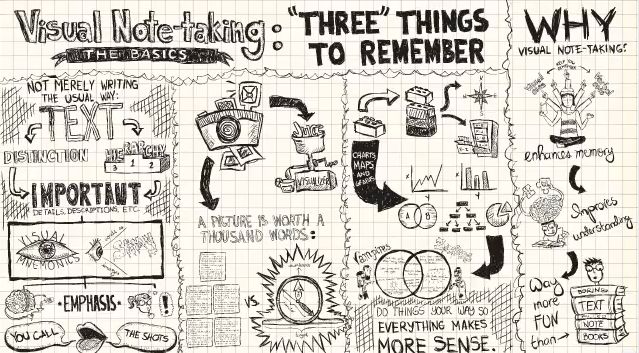In Term Two, as we prepared for our Inquiry Projects, we engaged in an exploration of the sketchnoting technique while watching episodes of the amazing Cosmos mini-series, which has a wonderfully direct correlation to the Big Ideas and content of the grade 6 and 7 Science Curriculum.

Sketchnoting is a powerful learning tool, as it encourages metacognitive thinking (thinking about thinking). Students are required to actively analyze the information they are viewing in order to classify and sort it, create visual mnemonics, and delineate different kinds and strengths of connections between ideas. I can report a 100% engagement level every Friday morning in our class, as we watched and sketchnoted from Sagan, Druyan, and deGrasse Tyson’s remarkable series.
It fills me with joy to see how differently each student works with the same material and concepts, and one of the beautiful aspects of sketchnoting is that you do it in the way that makes sense to you – as long as you are experimenting with a hierarchy of information, using structure and organization to sort the information, and using visuals when appropriate to capture ideas and concepts, anything goes. This form of active viewing and this way of thinking about thinking increases memory retention and makes plagiarism impossible, as you have used a minimum number of words to capture the information viewed or read. It’s also a lot of fun. Thank you, Mrs. Osiris of Chaffey-Burke (one of the most creative people I know), for turning me on to this amazing technique!
Here are some of the fruits of our labors (if I missed your work, it was because my phone ran out of room to store photos – I am plagued by this issue…).
Practice Round:
Submitted Work, Round 1:
Submitted Work, Round 2:
A good intro to sketchnoting can be found here. Be a Thought Curator and try it out! And while you’re at it, take a look at the original 1980 version of the Cosmos series – despite (or perhaps because of) the turtlenecks and the adenoidal tone, there are still few people who can bring the same sense of wonder and refinement of thought to science as Carl Sagan. Hop aboard the Ship of the Imagination and click on the first episode, here.



